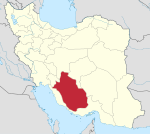Shapur cave
- View a machine-translated version of the Persian article.
- Machine translation, like DeepL or Google Translate, is a useful starting point for translations, but translators must revise errors as necessary and confirm that the translation is accurate, rather than simply copy-pasting machine-translated text into the English Wikipedia.
- Do not translate text that appears unreliable or low-quality. If possible, verify the text with references provided in the foreign-language article.
- You must provide copyright attribution in the edit summary accompanying your translation by providing an interlanguage link to the source of your translation. A model attribution edit summary is
Content in this edit is translated from the existing Persian Wikipedia article at [[:fa:غار شاپور]]; see its history for attribution. - You may also add the template
{{Translated|fa|غار شاپور}}to the talk page. - For more guidance, see Wikipedia:Translation.
29°48′12″N 51°36′41″E / 29.80333°N 51.61139°E / 29.80333; 51.61139
| UNESCO World Heritage Site | |
|---|---|
 | |
| Location | Fars Province, Iran |
| Criteria | Cultural: ii, iii |
| Reference | 1222 |
| Inscription | 2018 (42nd Session) |
Shapur cave (Persian: غار شاپور) is located in the Zagros Mountains, in southern Iran.[citation needed] This cave is near Kazerun in the Chogan valley.
In the cave, on the fourth of five terraces, stands the statue of Shapur I, the second ruler of the Sasanid Empire. The statue was carved from one stalagmite.[1] The height of statue is 7 metres and its shoulders are 2 meters wide, and its arms are 3 meters long.[1]
About 1400 years ago, after the Muslim conquest of Persia and collapse of the Sasanian Empire, the statue was pulled down and a part of one of its legs was broken. About 70 years ago, again, parts of his arms were also broken in an earthquake. The statue had been lying on the ground for about 14 centuries until 1957 when Mohammad Reza Pahlavi, the last Shah of Iran, had a group of Iranian military to raise it again on its feet and repair the broken foot with iron and cement.[2]
There are two inscriptions in the cave, one translates Shapur's own inscription on the Naqsh-e Rajab. The other is about the restoration of the statue by the Royal Iranian army under the Shah.[2]
Gallery
See also
- Sasanid architecture
- Naqsh-e Rustam
References
- ^ a b Habibollāh Āyatollāhi (2002). The Book of Iran:The History of Iranian Art. Centre for International Cultural Studies. ISBN 9789649449142. Retrieved 23 November 2018.
- ^ a b "Shapur Cave". TripYar. Archived from the original on 24 November 2018. Retrieved 23 November 2018.
- v
- t
- e
- Shiraz

and cities
- Afif-Abad Garden
- Amir's dam
- Arg of Karim Khan
- Barmdelak lagoon
- Bishapur
- Delgosha Garden
- Eram Garden
- Istakhr
- Ghal'eh Dokhtar
- Ka'ba-ye Zartosht
- Kazerun fire temple
- Lake Parishan
- Naqsh-e Rajab
- Naqsh-e Rustam
- Palace of Ardashir
- Sangtarashan cave
- Pars Museum
- Pasargadae
- Persepolis
- Qavam House
- Qur'an Gate
- Saadi's mausoleum
- Sarvestan Sassanian palace
- Shah Cheragh
- Colossal Statue of Shapur I in Shapur cave
- Tangeh Bolaghi
- Tomb of Ali ibn Hamzah, Shiraz
- Hāfezieh
- Tomb of Seyed Alaeddin Husayn
- Tounbbot
- Vakil Bath
- Vakil Bazaar
- Vakil Mosque
 | This Kazerun County location article is a stub. You can help Wikipedia by expanding it. |
- v
- t
- e



















